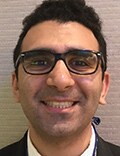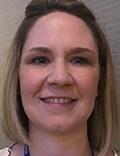ORLANDO — Patients with isolated hip fracture can be in the operating room within 48 hours of presentation, which can lead to improved outcomes, if a multidisciplinary team is focused on this goal, new research shows.

Morteza Komeylian
Hip fracture is “considered an urgent procedure, not an emergent procedure,” said lead investigator Morteza Komeylian, MD, from the University of Texas Medical Branch at Galveston.
However, many studies have shown that outcomes for patients with hip fracture are better the sooner they get to the operating room, Komeylian told Medscape Medical News.
If the surgery is delayed, hospital stay is longer and complications are more likely, “so it’s really important to operate within 48 hours,” he explained.
“An interdisciplinary plan of action was intently focused on the goal,” Komeylian said during a poster session here at the American Geriatrics Society (AGS) 2018 Annual Scientific Meeting, where the research won the AGS/Humana Value-Based Care Research Award.
“Cooperation between the team members resulted in a better outcome for these patients,” he explained. In fact, length of hospital stay and rate of in-hospital mortality both decreased.
When Komeylian and his colleagues took a serious look at how quickly their institution was getting isolated hip fracture patients to the operating room, they found that they were not doing as well as other institutions.

Erin Hommel
“We were noticing two things,” said investigator Erin Hommel, MD, also from the University of Texas Medical Branch at Galveston.
First, “we were seeing more and more cases of isolated hip fracture. And second, when we started to pay attention to benchmarking, we realized that our quality parameters were not up to par, particularly in relation to getting patients to the operating room in a timely fashion,” she told Medscape Medical News.
“In 2014, 73% of our isolated hip fracture patients received operative fixation within the recommended 48 hours of presentation, while peer benchmark was 88%. And our baseline perioperative complication rate was 12%, compared with an expected 6%,” she reported.
Komeylian, Hommel, and their colleagues decided to develop an interdisciplinary team to focus on doing a better job and implement a “culture shift.” They developed patient-placement algorithms, put geriatric assessment tools and order sets in place, and provided extensive faculty and resident education.
“Our team included anesthesiologists, surgeons, internists, geriatricians, and ancillary staff, like physical therapists and our trauma nurses,” Hommel said. “It helped that we had a health system that encouraged us to do better.”
Obstacles to the OR
The team identified two main obstacles to getting people to the operating room.
“The first was in the coordination of care. When the patient arrived in the emergency room, there was a delay in getting all of the different players in place to be able to take them to the OR,” Hommel explained. “The second was that once we realized they needed to go to the OR, we were delaying that because of unnecessary preoperative clearances, mostly cardiac clearance.”
Another thing that delayed the trip to the operating room was admittance to a medical team.
“Our orthopedic surgeons were sitting back and waiting for the family medicine, internal medicine, and geriatric teams to tell them when the patient was ready to go to the OR, rather than standing up and saying that they needed to take the patient to the OR,” she added.
Six months after the establishment of the focused interdisciplinary team, the goal — getting 88% of patients with isolated hip fracture to the operating room within 48 hours of presentation — was achieved. In 2016, that rate rose to 94%, and in 2017, to 96%.
In addition, median hospital stay decreased from 6 days at baseline to 5 days after implementation, and in-hospital mortality decreased from 5.0% to 3.2%.
Besides doing away with unnecessary steps, such as cardiac clearance before surgery, Komeylian said he would like to see more patients treated for osteoporosis.
A lot of the patients we see have already been diagnosed with osteoporosis but they are not on the right medication.
“A lot of the patients we see have already been diagnosed with osteoporosis but they are not on the right medication. They may be on calcium and perhaps vitamin D, but all too often, maybe about 10% of our patients are on bisphosphonates or similar meds to strengthen the bones. This is not good because 100% of our patients require bisphosphonates,” he pointed out.
“Many patients are not being discharged with bisphosphonates, either. These are relatively inexpensive medications and they are not being prescribed appropriately,” he added.
Teamwork Always a Good Idea

Alayne Markland
This study shows the positive implications of “practice change and quality improvement,” said Alayne Markland, DO, from the University of Alabama at Birmingham.
“I know that the AGS — in conjunction with other societies and other people, such as orthopedic providers — is trying to link our services to determine what can we do together to improve outcomes,” she told Medscape Medical News.
“As geriatricians, we have always worked in teams, so we know how important teamwork is to achieving better outcomes for patients,” she said.
“Working as a team can achieve better outcomes,” Markland pointed out. “The algorithms and processes that were used at this center may not be applicable to all centers, and the teams can vary from hospital to hospital, but having the right mix of people all moving in the same direction can not only improve short-term outcomes, like of length of stay, but perhaps longer-term outcomes, too.”
Komeylian, Hommel, and Markland have disclosed no relevant financial relationships.
American Geriatrics Society (AGS) 2018 Annual Scientific Meeting. Presented May 3, 2018.
Follow Medscape on Twitter @Medscape
Tidak ada komentar:
Posting Komentar